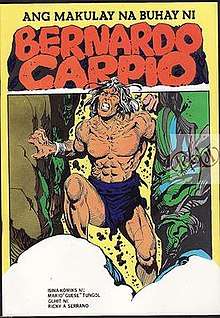Bernardo Carpio
| Bernardo Carpio | |
|---|---|
 Bernardo Carpio story as depicted in the comics. | |
| Gender | Male |
| Region | Philippines |
| Equivalents | |
| Asturias equivalent | Bernardo del Carpio |
Bernardo Carpio is a legendary figure in Philippine mythology who is said to be the cause of earthquakes. There are numerous versions of this tale. Some versions say Bernardo Carpio is a giant, as supported by the enormous footsteps he has reputedly left behind in the mountains of Montalban. Others say he was the size of an ordinary man. Accounts of the stories have pre-colonial origins, but the name of the hero was Hispanized during the Spanish colonization. The original name of the hero has been lost in time. All versions of the story agree that Bernardo Carpio had a strength that was similar to that of many strong men-heroes in Asian epics, such as Lam-ang.
Basic legend
The basic form of the legend is that Bernardo Carpio, a being of great strength, is trapped in between two great rocks in the Mountains of Montalban.
Some versions say he is keeping the mountains from crashing into each other (similar to the Greek titan Atlas holding up the sky), and some versions say he is trapped and trying to break free. When Bernardo Carpio shrugs his shoulder, an earthquake occurs.
As a revolutionary against Spanish occupation
According to one version of the tale, Bernardo Carpio was a son of Infante Jimena and Don Sancho Díaz of Cerdenia. The Infante was cloistered by her brother King Alfonso, who at that time was very powerful, because of her forbidden love with Don Sancho. Don Sancho was incarcerated, and his eyes were to be plucked out. Bernardo was left to the care of Don Rubio, who divulged the love affair.
The Spanish hired a local engkantado (shaman) and conspired to trap Carpio through supernatural means. Calling for a parley, they lured him towards a cave in the mountains of Montalban. The engkantado used his agimat (talisman), and Bernardo Carpio was caught between two boulders which the shaman had caused to grind each other. The legend says he was not killed, but was trapped between these two boulders, unable to escape because the talisman's power was as great as his own strength.
When Carpio's allies arrived at the cave to rescue him, they were blocked from the cave by a series of cave ins that killed several of them.
People soon surmised that whenever an earthquake happens, it is caused by Bernardo Carpio trying to free himself from the mountain.[1]
Etymology
The same version says that Bernardo Carpio demonstrated unusual strength, even as a child. As a result, the parish priest who baptised him suggested that his parents name him after the Spanish legendary hero Bernardo del Carpio. This became a foreshadowing of the legendary life Carpio himself would lead.
As symbolism of freedom from the U.S. and Japan
Damiana Eugenio was able to find and document a 1940 compilation of tales detailing the legend of Bernardo Carpio.[2] It specifically says that:
"Bernardo Carpio is considered the savior of the Filipinos against national oppression and enslavement".
According to that particular telling of the tale, when the last link on the chains binding Carpio is broken, "the enslavement and oppression of the Filipino race will be replaced with freedom and happiness." While this belief apparently referred to the Spanish Occupation of the Philippines and the later occupation by the Philippines by the U.S. and by Japan in World War II, the legend has continued to be told this way, an apparent reference to freedom from poverty rather than foreign domination.
Filipino revolutionary heroes Jose Rizal and Andres Bonifacio are said to have paid homage to the Bernardo Carpio legend - the former by making a pilgrimage to Montalban, and the latter making the caves of Montalban the secret meeting place for the Katipunan movement.[3]
As an etiological myth
The tale of Bernardo Carpio can be considered an etiological myth which explains the occurrence of earthquakes.[4] The area which hosts the legend of Bernardo Carpio is also home to the West Valley Fault System (formerly called the Marikina Valley Fault System).[5]
In popular literature
- Lav Diaz's 2016 film A Lullaby to the Sorrowful Mystery (Filipino: Hele Sa Hiwagang Hapis) prominently features a tikbalang (played as a triune being played by Bernardo Barnardo, Cherie Gil, and Angel Aquino) which is revealed to be the engkanto who made a deal with the Spanish rulers to bind Bernardo Carpio, effectively allowing the Spanish to rule over the leaderless people. Towards the end of the film, however, the Tikbalang reveals that it/they never chained up Bernardo Carpio because he is just a myth, noting that it is foolish to hope for salvation from a figment of the imagination.
References
- Eugenio, Damiana (2002). Philippine Folk Literature: The Legends. University of the Philippines Press. pp. 4–5. ISBN 971-542-357-4.
- "Ang Alamat ni Bernardo Carpio: A Philippine Legendary Hero". The Katig Group. 2006-01-05. Retrieved 2007-01-13.
- "The Valley Fault System". Philippine Institute of Volcanology and Seismology. Archived from the original on 2007-03-07. Retrieved 2007-01-15.
- Ocampo, Ambeth (August 17, 2007). "Looking Back: Natural calamities". Philippine Daily Inquirer. Archived from the original on September 21, 2007.
Footnotes
- ↑ Ang Alamat ni Bernardo Carpio (A Philippine legend) by Katig.Com
- ↑ Eugenio, 2002, pp.3-4
- ↑ Ocampo,2007
- ↑ Eugenio, 2002
- ↑ The Valley Fault System Archived March 7, 2007, at the Wayback Machine.